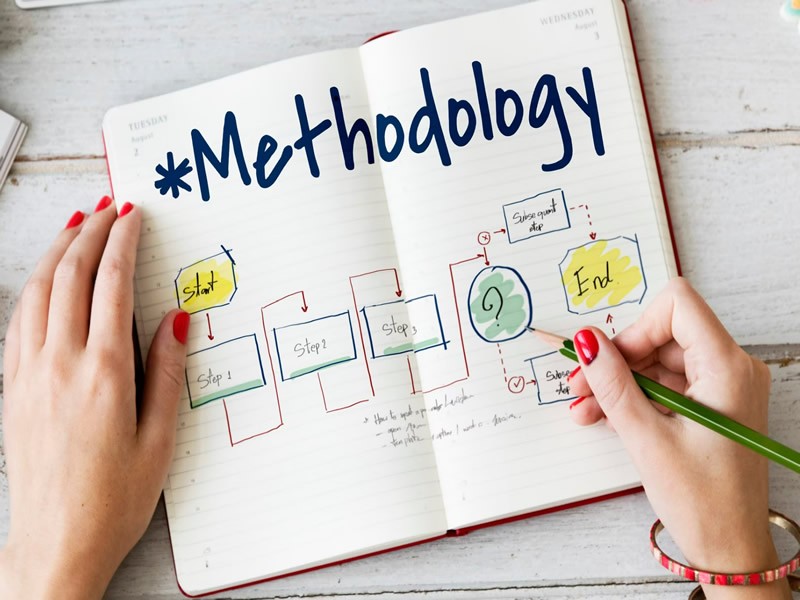Insight Blog
Agility’s perspectives on transforming the employee's experience throughout remote transformation using connected enterprise tools.
10 minutes reading time
(2053 words)
Waterfall Methodology Vs. Agile Methodology: Comparing Software Testing Approaches
In the fast-paced world of software testing, Waterfall and Agile testing approaches are two giants that stand tall, each with its unique approach and philosophy.
In the fast-paced world of software testing, Waterfall and Agile testing approaches are two giants that stand tall, each with its unique approach and philosophy.
Waterfall has been a trusted methodology for years, following a linear path from requirements to deployment.
On the other hand, Agile has taken the industry by storm, revolutionizing how software is developed and tested.
Today, we will look into the intricacies of these methodologies and explore their impact on software testing.
Overview Of The Waterfall And Agile Methodologies
Let's start with is agile a methodology, the answer to this question is yes. Waterfall and Agile methodologies guide software development projects and shape how teams approach planning, execution, and delivery.
Waterfall methodology, a traditional and structured approach. Imagine a majestic waterfall cascading down linearly and sequentially.
Similarly, the Waterfall methodology follows a step-by-step process, where each phase must be completed before moving on to the next. If a developer wants to learn how to do automation testing, then they should be ready to understand these methodologies, because it provides developers with insights into different approaches to software development and testing.
Especially Waterfall methodology which is a clear roadmap with well-defined requirements and deliverables. However, like a waterfall, this methodology can be rigid and unforgiving, making it challenging to adapt to changing requirements and unexpected twists in the project.
Conversely, we have the Agile methodology, a dynamic and flexible approach that resembles a thrilling roller coaster ride. Agile embraces change and encourages collaboration among team members.
It focuses on iterative development, where small increments of the software are delivered frequently, allowing for continuous feedback and improvement.
Agile empowers teams to respond swiftly to customer needs and market demands, ensuring a more adaptable and customer-centric approach.
While the Waterfall methodology provides stability and predictability, Agile brings agility and responsiveness.
Both methodologies have their strengths and weaknesses, and the choice depends on the project's nature, team dynamics, and customer requirements.
Some projects may thrive under the structured nature of Waterfall, while others may flourish in the dynamic environment of Agile, let learn a bit more about eh benefits if
Key Benefits of Using the Waterfall Methodology
The Waterfall methodology relies on a sequential progression of steps, where each phase must be completed before moving forward. This structured approach is well-suited for smaller projects with clearly defined deliverables from the outset.
According to Ben Aston from The Digital Project Manager, Waterfall is often criticized as an inefficient and outdated project management approach. However, there are situations where Waterfall can be valuable and predictable.
This occurs when requirements are fixed, well-documented, and clear, when the technology is well-understood and mature, when the project is short in duration, and when there is no significant advantage in adopting an Agile approach. In such cases, Waterfall can provide a more predictable outcome in terms of budget, timeline, and scope.
- The Waterfall model follows a sequential and linear approach, with distinct phases and well-defined objectives. This provides a clear structure for project planning and execution.
- Waterfall places strong emphasis on documentation throughout each phase of the project. This documentation ensures a thorough understanding of requirements, design, and implementation, which can be valuable for future reference and knowledge transfer.
- The sequential nature of the Waterfall model allows for better predictability in terms of project timeline, budget, and scope. With upfront planning and fixed requirements, it becomes easier to manage and control the project's progress.
- In projects where customers have limited availability or prefer a hands-off approach, the Waterfall model can be advantageous. It allows customers to provide requirements at the beginning and then wait for the final product, reducing the need for constant customer involvement throughout the development process.
- The Waterfall model is particularly effective for smaller projects with clear and well-understood requirements. When the project scope and deliverables are easily defined from the start, the Waterfall approach can provide a structured and efficient way to proceed.
While the Waterfall model has its advantages, it's important to consider the specific project requirements and circumstances to determine whether this approach is the most suitable choice.
Key Benefits of Using the Agile Methodology
Agile has emerged as a highly favored project management approach due to its adaptability and evolutionary nature. Originally introduced in 2001 with the Agile manifesto, it was initially designed for software development. However, over time, agile project management has evolved and gained popularity across various industries.
In essence, Agile is an iterative and incremental project management approach that enables teams to effectively address the dynamic demands of the modern workplace.
It encompasses a range of methodologies, all rooted in the principles of flexibility, transparency, quality, and continuous improvement.
- Agile methodology offers increased control through its incremental approach. Breaking work into manageable parts and conducting rapid iterative cycles allows for regular meetings to share progress, address challenges, and find solutions. This transparency fosters better collaboration and enables more effective project management.
- The incremental nature of Agile ensures projects are completed in shorter sprints, enhancing manageability. It facilitates quicker product rollouts and allows for easy incorporation of changes throughout the process, leading to improved productivity.
- The iterative aspect of Agile methodology enables rapid problem identification and solution development. The flexibility of Agile empowers project teams to respond promptly to customer feedback and continuously enhance the product, resulting in superior quality outcomes.
- Agile promotes close collaboration between project teams and customers, facilitating immediate feedback and adjustments. Customers have the opportunity to fine-tune their expectations and preferences throughout the process, leading to a higher level of customer satisfaction.
- The iterative nature of Agile ensures faster time-to-market for the end product, giving it a competitive edge and yielding quicker benefits. Agile's advantages, such as cost reduction, shortened time to market, improved application quality, and enhanced customer satisfaction, contribute to a higher return on investment. When it comes to agile working.
How do Waterfall and Agile compare?
Agile practitioners understand the unpredictable nature of software development, where plans often deviate.
As a result, the key differentiating factor between Waterfall and Agile lies in the commitment to continuous software delivery to clients.
Waterfall and Agile are two contrasting approaches to software development, each with its own strengths and characteristics.
In the Waterfall model, development progresses through sequential phases, with each phase dependent on the completion of the previous one. This method follows a structured and predetermined plan, with upfront requirements gathering and documentation.
Once the requirements are defined, development begins, followed by testing and deployment.
Waterfall is often characterized by a linear flow and limited customer involvement until the final product is delivered.
Agile, on the other hand, is an iterative and flexible approach to software development. It emphasizes adaptive planning, collaboration, and continuous improvement.
Agile projects are divided into short iterations called sprints, where small increments of the product are developed, tested, and reviewed.
Customer involvement is highly encouraged throughout the process, allowing for frequent feedback and the ability to adapt to changing requirements. Agile promotes cross-functional teams, regular communication, and embraces change as a natural part of the development cycle.
Comparing Waterfall and Agile, some key differences emerge:
- Agile is highly flexible and adaptive, enabling changes to be incorporated throughout the development process. In contrast, Waterfall is less flexible and requires upfront planning, making it challenging to accommodate changes once development has started.
- Agile encourages active customer involvement and feedback, fostering collaboration and ensuring the final product meets customer expectations. Waterfall, on the other hand, typically involves less customer engagement until the final product is delivered.
- Agile follows an incremental and iterative approach, allowing for the delivery of working software in shorter cycles. Waterfall follows a sequential approach, with each phase completed before moving to the next, resulting in a longer development timeline.
- Agile mitigates risks by addressing them early and incorporating changes as needed. Waterfall relies on thorough upfront planning to minimize risks, but it may be less effective in handling unexpected challenges.
Choosing between Waterfall and Agile depends on the project's requirements, complexity, and customer involvement. Waterfall is suitable when requirements are stable and well-defined, while Agile is favored for dynamic projects that require flexibility, customer collaboration, and the ability to adapt to evolving needs.
Importance Of Software Testing In Both Methodologies
Software testing is a crucial element in both Agile and Waterfall methodologies.
The importance of software testing cannot be overstated, as it serves as a robust safety net, ensuring that the final product meets the highest standards of quality and reliability.
Software testing companies like Quality Logic apply these principles across Agile and Waterfall environments. It helps teams systematically validate software, mitigate risks, and meet compliance standards, particularly in specialized areas such as digital accessibility and smart energy testing.
Software testing is integral to each sprint in the Agile methodology, characterized by its iterative and incremental approach.
This iterative nature introduces an element of unpredictability, where requirements may evolve and change throughout the development process.
Software testing identifies defects or issues early, allowing quick adjustments and refinements.
By performing thorough testing during each iteration, the Agile team can ensure that the software meets customer expectations and maintains a high level of quality throughout the development lifecycle.
In the Waterfall methodology, where a sequential and structured approach is followed, software testing assumes a different but equally critical role. The linear nature of the Waterfall approach may seem more predictable, but the possibility of unforeseen issues and risks remains.
Software testing acts as a crucial checkpoint, ensuring that each phase is completed successfully before moving on to the next.
By conducting comprehensive testing at each stage, including unit, integration, and system testing, the Waterfall team can identify and address defects early on, minimizing the risk of downstream issues.
Agile vs. Waterfall in Software Development
Waterfall and Agile testing approaches are two distinct methodologies that navigate software development's unpredictability and randomness.
While both approaches aim to ensure the delivery of high-quality software, they differ significantly in their processes, adaptability, and response to change.
- Agile methodology emphasizes early testing and validation during the software development lifecycle.
- The continuous delivery approach in Agile aligns with the continuous deployment model of DevOps.
- The Agile feedback loop actively engages stakeholders in the development process.
- Agile facilitates easier adaptation to changed requirements during the course of development.
- Agile projects are simpler to initiate as they do not rely on complete requirements and lengthy analysis cycles.
Is it possible to combine Agile and Waterfall?
In the ongoing Agile vs. Waterfall debate, there are passionate advocates on both sides. However, in practice, many software projects combine elements of both methodologies. This hybrid approach is commonly known as Agilefall or Wagile.
Certain industries, such as banks, insurance companies, and governments, tend to follow a more Waterfall-like process. They place emphasis on upfront requirements gathering, thorough project scoping, budget analysis, and obtaining sign-off from stakeholders.
Once development begins, these organizations often transition to an Agile framework like Scrum or Kanban or a combined version of these two
They adopt iterative development practices and allow for changes to the plan as software is continuously delivered to the customer. This flexibility embodies the core principles of agility.
Over the past two decades, there has been a notable industry shift away from Waterfall towards Agile methodologies. Embracing an Agile approach is generally recommended as the preferred development strategy.
However, it's worth noting that incorporating some elements of Waterfall into the Agile mix is not uncommon or frowned upon. Many organizations find a balance between the two methodologies that works best for them.
Ultimately, the choice between Agile, Waterfall, or a combination thereof depends on the unique needs and context of each project and organization.
Wrapping up
The comparison of Waterfall and Agile testing approaches highlights the significance of adapting to software development's inherent unpredictability and randomness.
The key lies in understanding the unique characteristics of each approach and choosing the one that aligns best with the project's requirements and level of unpredictability. Successful software testing requires thoughtful consideration of the project's complexity, timeline, and flexibility.
Categories
Blog
(2622)
Business Management
(323)
Employee Engagement
(212)
Digital Transformation
(176)
Growth
(119)
Intranets
(116)
Remote Work
(61)
Sales
(48)
Collaboration
(36)
Project management
(29)
Culture
(28)
Customer Experience
(26)
Knowledge Management
(21)
Leadership
(20)
Comparisons
(6)
News
(1)
Ready to learn more? 👍
One platform to optimize, manage and track all of your teams. Your new digital workplace is a click away. 🚀
Free for 14 days, no credit card required.











![What Is an Intranet for Business? [2026 Guide] What Is an Intranet for Business? [2026 Guide]](http://agilityportal.io/images/easyblog_articles/1496/b2ap3_thumbnail_What-Is-an-Intranet-for-Business.png)


